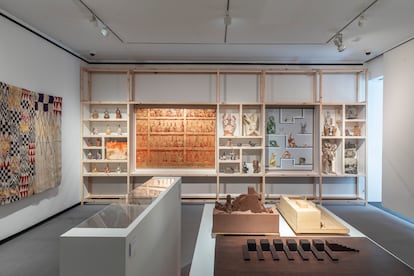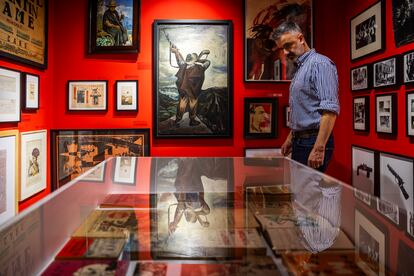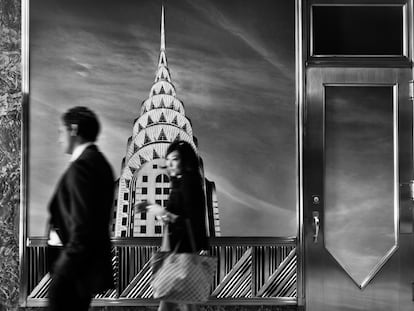Amerindian art’s sweet revenge: From underappreciated to the star attraction in museum exhibitions
Two exhibits in Madrid and one in Bogotá show the increasing value of Latin American indigenous expressions that were historically considered inferior

Throughout history, indigenous American creative expressions like ceramics, textile and feather art have been disparaged as minor arts and crafts or primitive art. Nowadays, these modes of representation are featured in flagship museums of contemporary art like the Tate and the Barcelona Museum of Contemporary Art (MACBA), which paved the way for Chilean artist Cecilia Vicuña to receive the Golden Lion at the 2022 Venice Film Festival. The Juan March Foundation’s Before America exhibit and the Arkhé Archive’s America: A Short Natural and Political History exhibit, both in Madrid, Spain, offer a historical journey through these pre-Hispanic art forms, from their reduction to archeology in the 19th century to their current international prominence.
The fact that National Plastic Arts Award went to Spain’s Teresa Lanceta, who does some of her weavings in designs from the Peruvian Paracas culture, and that Aymara Elvira Espejo won the Goethe Medal attest to the West’s recognition of practices that it had traditionally marginalized. “Let’s hope it’s not a fad,” says Rodrigo Gutiérrez, the curator of the Before America exhibit. Open through March 10, 2024, the exhibition traces Amerindian influences in modern and contemporary art through 630 pieces from 143 lenders. It begins with European travelers’ stereotypical depictions of native peoples and ends with one wall for ceramics and another wall for textile art. “The end doesn’t focus on painting and sculpture [because] we are overcoming a sort of hegemony,” says Gutierrez, a professor of art history at the University of Granada.
Open until November 20, the America: A Short Natural and Political History exhibit also begins in the 19th century with foreign adventurers’ prints from that period. The exhibit then gives way to photographs, paintings, sculptures, magazines and posters that tell how the indigenous has gradually gained ground in the Americas. “There are many contemporary artists who see the Indian question—its poetics, politics and struggles—as a fundamental source of creative inspiration. There are indigenous creators like Abel Rodriguez and Delcy Morelos who make art from their own places,” says Halim Badawi, who is the co-director of the Arkhé Archive with Pedro Hinostrosa. The fund was set up in Madrid, Spain, early this year and houses 80,000 documents divided between a queer archive and a Latin American art archive.
Colombian art historian Maria Wills believes that the rise of popular indigenous art is a fad in Europe, but a long-standing need in Latin America. Along with Sigrid Castañeda and Julien Petit, Wills is one of the three curators of Sowing Doubt, an exhibition at Bogota’s Miguel Urrutia Art Museum similar to the exhibits in the Spanish capital. The Colombian exhibition showcases 800 works that were selected with native communities and reflect on indigeneity since colonial times.
The curators make it clear that, in order to occupy spaces in art, indigenous peoples first had to gain a place in contemporary politics and on the social agenda. The new constitutions of Colombia (1991), Ecuador (2008) and Bolivia (2009) recognized the nations’ ethnic pluralities, and indigenous identities existed in the eyes of the State for the first time. “That’s the feeling in Latin America as a whole. For a long time, scientists [and] religious figures spoke for indigenous people; today, an authentic voice has become possible, as we saw in the 1994 Mayan rebellion in Chiapas (Mexico), in the vindication of the Yanomami lands,” Castañeda argues.
According to Petit, Indo-American communities’ spiritual connections with nature are another reason for the West’s fixation with these cultures. The climate crisis forces us to take a closer look at indigenous peoples’ respectful coexistence with the environment, which is typical of pre-Columbian philosophies. “Areas that the West had labeled as savage ended up providing the answers that the world needs more than ever,” Petit says.
The 19th century: The Indian as an exotic attraction
Third party interpretations of indigenous forms were especially evident in the 19th century. Motivated by attempts to understand the unknown, European travelers depicted cultural expressions that they reduced to ethnological components in the drawings, engravings and photographs they produced. One example of that trend is a series of anonymous watercolors entitled “Peruvian Customs,” which portrays daily chores; Belgian consul Edouard Lowes’s 1895 photographs of Guatemalan natives also reflect this phenomenon. These series of depictions, both of which are housed at the Arkhé Archive, represented the predominant visual imaginary of the continent. Similar works were reproduced repeatedly and became clichés and prejudices.
“These travelers tended to see the Indians as a homogeneous and exotic group. They lumped together their gestures, facial features, simplifying and homogenizing groups that were really very diverse,” says Castañeda. In their efforts to appeal to the European academy in the late 19th century, Latin American governments tended to combine Aztec, Inca and Mayan symbols with architecture, blending the pre-Columbian with “fine arts.” Before America includes several Ibero-American countries’ pavilion designs from universal expositions that reflect this approach, including Mexico’s 1889 contribution.

In the 20th century, the Latin American centennials of independence and World War I called into question the values of the Western canon, which had been unquestioned until then. Along with the unequal distribution of land and structural racism, that questioning forced a rethinking of the role of indigenous peoples. The indigenista (pro-indigenous) movement emerged in this context in the first decades of the 20th century with standard-bearers like Peruvian José María Arguedas and led to the establishment of teaching centers for manual trades, such as the Popayán Ceramics School in Colombia and the Warisata School in Bolivia, as well as specialized publications, like Amauta magazine.
Ecuadorian artist Camilo Egas’s oil painting “Repose” (1925), which is exhibited at the Arkhé Archive, comes from that period. It shows a change in how indigeneity was represented, from the stereotyped version of the 19th century to a more multifaceted one. “There is anger but also suffering in the painting. Egas rejects facile categorizations and blurs the indicators of place and origin: the landscape is arid, but the characters are barefoot, there is a hill in the background, but the black marks on their faces indicate that they could be from the jungle,” Badaw analyzes. Another example at Arkhé is Manizales-born Alipio Jaramillo’s “Violence in the Countryside” (1948-1950), in which the artist depicts a guerrilla fighter in typical Andean garb. Indians figured prominently in the many popular insurrections that occurred throughout Latin America during the 20th century.

While America: A Short Political and Natural History highlights the 20th-century social component, Before America emphasizes the influence of pre-Hispanic symbols and ornamentation in popular art. Amerindian symbology was used to design jewelry, necklaces, furniture, carpets, scenery for plays such as Ollantay and even playing cards. The same interest in the “primitive” that attracted Gauguin and Picasso in Paris also influenced Latin American artists living in the French capital. Thus, art production in the region in the mid-20th century (1940-1960) was characterized by an attempt to combine pre-Columbian heritage with avant-garde discourses. That was how geometric abstraction emerged on the continent. At the March Foundation, one can see pieces that reflect this trend, such as Joaquin Torres Garcia’s “Composition” (1934), Augusto Torres’s “Green Abstract” (1936) and Carmelo Arden Quin’s “Untitled, or The Indians “(1948).
Badawi believes that this combination of Amerindian symbology and abstract influences offers “beautiful but imported forms” that take the reality of the indigenous communities out of context. This was the main criticism of last century’s indigenista movement: white or mestizo authors spoke for indigenous peoples. And this shift in the paradigm is the main feature of contemporary indigenous expressions. The subjects themselves tell the story of their own practices.
Sign up for our weekly newsletter to get more English-language news coverage from EL PAÍS USA Edition
Tu suscripción se está usando en otro dispositivo
¿Quieres añadir otro usuario a tu suscripción?
Si continúas leyendo en este dispositivo, no se podrá leer en el otro.
FlechaTu suscripción se está usando en otro dispositivo y solo puedes acceder a EL PAÍS desde un dispositivo a la vez.
Si quieres compartir tu cuenta, cambia tu suscripción a la modalidad Premium, así podrás añadir otro usuario. Cada uno accederá con su propia cuenta de email, lo que os permitirá personalizar vuestra experiencia en EL PAÍS.
¿Tienes una suscripción de empresa? Accede aquí para contratar más cuentas.
En el caso de no saber quién está usando tu cuenta, te recomendamos cambiar tu contraseña aquí.
Si decides continuar compartiendo tu cuenta, este mensaje se mostrará en tu dispositivo y en el de la otra persona que está usando tu cuenta de forma indefinida, afectando a tu experiencia de lectura. Puedes consultar aquí los términos y condiciones de la suscripción digital.
More information
Últimas noticias
Aquilino Gonell, former Capitol sergeant: ‘If it hadn’t been for the police, the US would be a dictatorship’
A hybrid building: Soccer pitch, housing, and a shopping mall
Europe urges Trump to respect Greenland following annexation threats
Science seeks keys to human longevity in the genetic mixing of Brazilian supercentenarians
Most viewed
- Alain Aspect, Nobel laureate in physics: ‘Einstein was so smart that he would have had to recognize quantum entanglement’
- Mexico’s missing people crisis casts a shadow over World Cup venue
- Why oil has been at the center of Venezuela-US conflicts for decades
- Alvin Hellerstein, a 92-year-old judge appointed by Bill Clinton, to preside over Maduro’s trial in New York
- Cuba confirms death of 32 of its citizens in the US attack against Venezuela










































